stop start AUDI A6 2016 User Guide
[x] Cancel search | Manufacturer: AUDI, Model Year: 2016, Model line: A6, Model: AUDI A6 2016Pages: 294, PDF Size: 73.88 MB
Page 78 of 294
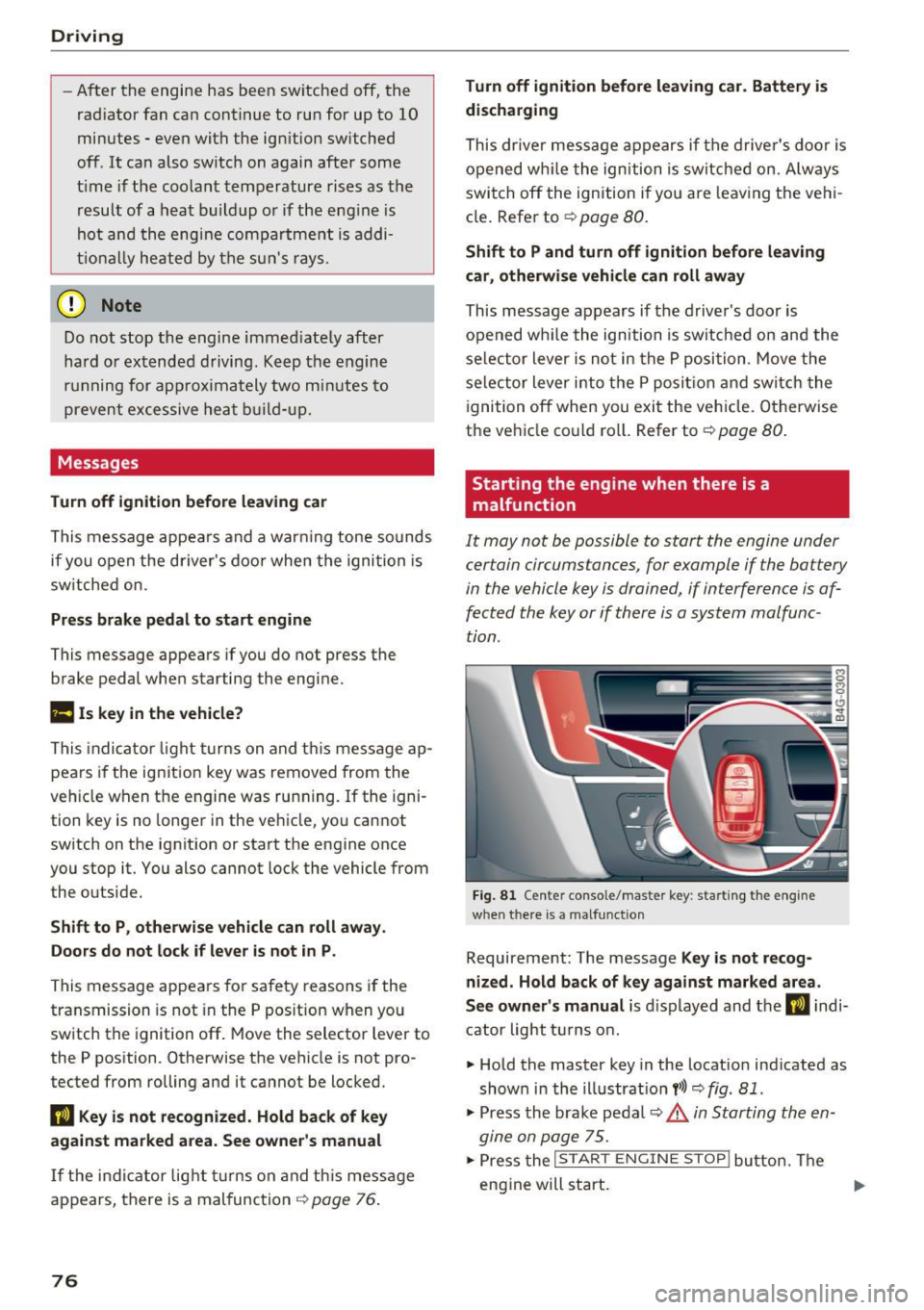
Driving
-After the engine has been sw itched off, the
rad iator fan can continue to run for up to 10
minutes - even with the ign ition switched
off . It ca n also switch on again after some
t ime if the coolant temperature rises as the
r esult of a heat buildup o r if the eng ine is
hot and the eng ine compartme nt is addi
ti onal ly he ated by the su n's rays.
@ Note
Do not stop the engine immed iate ly after
hard o r ex tended d riving. Keep the engine
running for app rox im ately two m inutes to
prevent exces sive hea t build-up.
Messages
Turn off ignition before leaving car
T his message appe ars and a warn ing tone so unds
if you o pen the d river's door when the ignition is
sw itche d on .
Press brake pedal to start engine
This message appea rs if you do not press the
brake pedal whe n starting the engine.
fll Is key in the vehicle?
T his indi cato r light turn s on and t his mess age ap
pea rs i f the ig nition key was removed from the
ve hicle when t he engine was ru nning. If the igni
tion key is no longer in the veh icle, yo u can not
switch on the ignition or start the engine once
you stop it. You also cannot lock the vehicle from
the outside.
Shift to P , otherwise vehicle can roll away .
Doors do not lock if le ver is n ot in P.
This message appears for safety reasons if the
transmission is not in the P pos it ion when you
sw itch the ignition off . Move the selector lever to
the P position. Otherwise the vehicle is not pro
tected from rolling and it ca nnot be locked.
DJ Key is not recognized. Hold back of key
against marked area . See owner's manual
If the i ndicator lig ht tu rns on and th is mess age
appears, there is a mal function
q page 76 .
76
Turn off ignition before leaving car. Battery is
discharg ing
This driver message appears if the drive r's door is
opened wh ile the ign ition is switche d on. Always
swi tch off the ignition i f yo u are leav ing the ve hi
cle. Refer to
~ page 80.
Shift to P and turn off ignition before leaving
car, otherwise vehicle can roll away
This message appears if the d river 's door is
opened wh ile the ignition is switc hed on and the
selector lever is not in the P po sition . Move the
selector lever i nto the P posi tion and sw itch the
igni tion off when you exit the veh icle. O therwise
the ve hicle co uld ro ll. Refer to~
page 80 .
'
Starting the engine when there is a
malfunction
It may not be possible to start the engine under
certain circumstances, for example if the battery
in the vehicle key is drained, if interference is af
fected the key or if there is a system malfunc
tion.
F ig. 81 Cente r conso le/mas te r key : sta rting the eng ine
w hen th ere is a malfunct io n
Requirement: The message Key is not recog
nized. Hold back of key against marked area .
See owner's manual
is d isplayed and t he DJ indi
c at or light t urns o n.
• Hold the master key in the locat io n ind icated as
show n in the ill ustrat io n
y>l) q fig . 81 .
• Press the bra ke pe dal q &_ in Starting the en
gine on page 75.
.,. Press the ~I S_ T_A_R_ T_E_ N_G_I_N_E_S_ T_O_P ~I bu tto n. Th e
eng ine will s tart.
Page 79 of 294
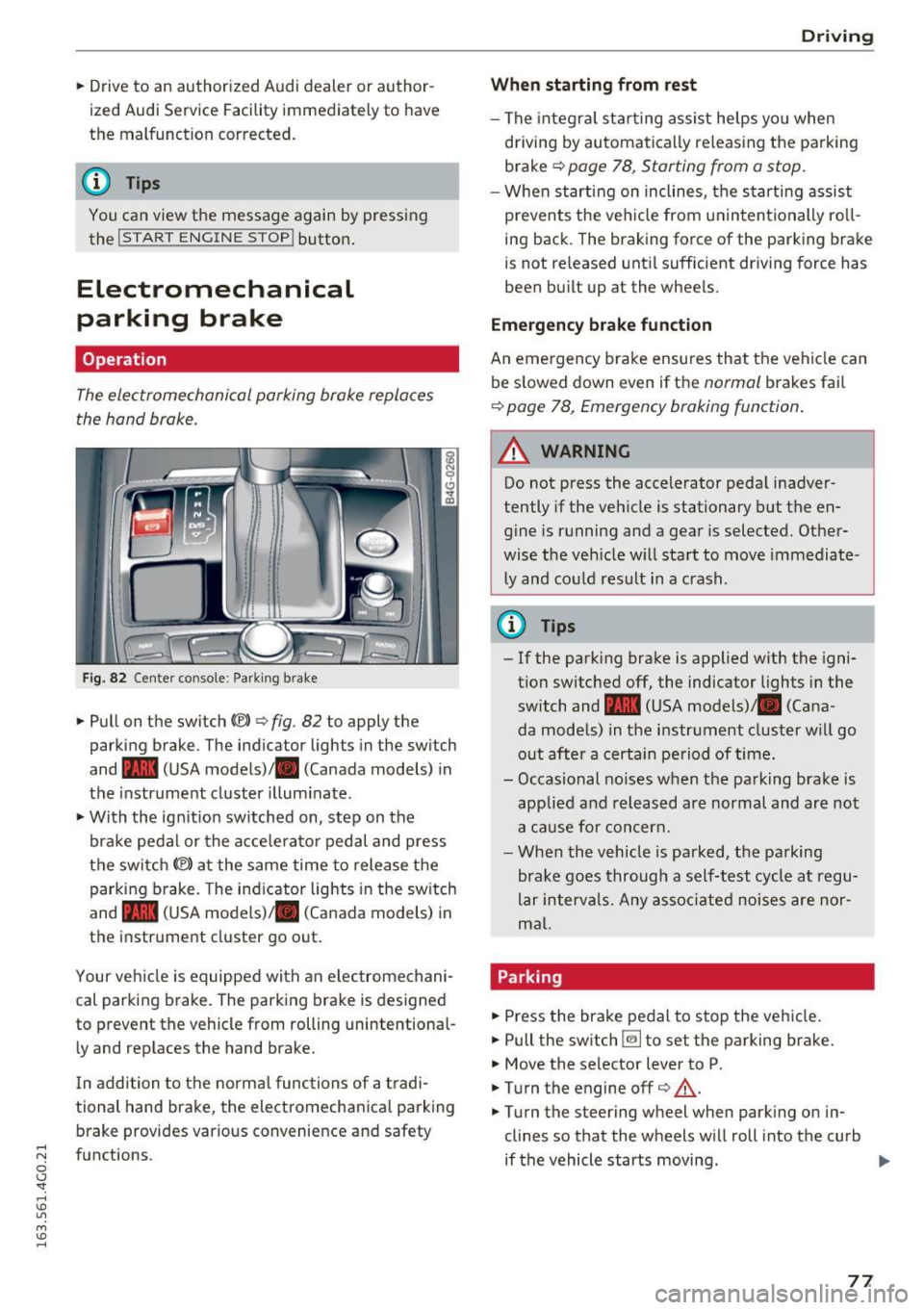
.. Drive to an authorized A udi dealer or author
ized Audi Service Facility immediately to have
the malfunction corrected.
@ Tips
You can view the message again by pressi ng
the
I START E NGINE STOP! button.
Electromechanical
parking brake
Operation
The elec trome chanical parking brake replaces
the hand brake.
Fig. 8 2 Center co nsole : Park ing b rake
.. Pull on the switch C®> c> fig . 82 to apply the
parking brake . The ind icator lights in the sw itch
and - (USA
models) ,11 (Canada models) in
the instr ument cluster illum inate .
.. With the ign it ion sw itched on, step on the
bra ke pedal or the a cce le rato r pedal and press
the switch
(®) at the same time to release t he
parking b rake. The ind icator lights in the sw itch
and - (USA
models) ,11 (Canada models) in
the instrument cluster go out .
Your ve hicle is equipped with an e lec tromechani
cal parking brake. The parking brake is designed
to prevent the vehicle from rolling unintentional
l y and rep laces the hand brake.
I n addition to t he norma l func tions of a tradi
tional hand brake, the electromechanica l parking
b rake provides various conve nience and safety
;::j fu nctions .
0 CJ '
Drivi ng
When starting from rest
-The integra l sta rting assist helps yo u when
driving by au toma tically re leas ing the parking
brake
Q page 78 , Starting from a stop.
- When start ing on inclines, t he s tarti ng assist
prevents the veh icle from un in ten tionally ro ll
ing back . The braking force of the parking bra ke
is not re leased unti l sufficient dr iving force has
been bu ilt up at the whee ls.
Emergency brake function
An emergency brake ensures that t he vehicle can
be s lowed down even if t he
normal brakes fail
Q page 78, Emergency braking function .
A WARNING
--
Do not press the accelerator peda l inadver
tently if the veh icle is stationary but the en
g ine is running and a gear is selected. Other
wise the veh icle w ill sta rt to move immediate
l y and co uld res ult in a crash.
@ Tips
- If the park ing bra ke is applied w ith the igni
tion switched off, the indicator lights in the
switch and -(USA
models) ,11 (Cana
da models) in the instr ument cluster will go
out afte r a certain pe riod of time.
- Occasional noises when the parking brake is
applie d and released are normal and are not
a ca use for con cern.
- When the vehicle is pa rked, the parking
brake goes through a self-test cycle at regu
lar in tervals. Any as so ci ate d noi ses are nor
ma l.
Parking
.. Press the brake pedal to stop the veh icle.
.. Pull the switch ~ to set the pa rking brake .
.. Move the selector lever to P .
.. Turn the engine off
c> &, .
.,. Turn the steering wheel when park ing on in
clines so that the wheels w ill roll into the curb
if the vehicle starts moving.
77
...
Page 80 of 294

Driving
& WARNING
-Always take the vehicle key with you when
leaving the vehicle, even for a short period
of time. This a pplies particularly when chi l
dren rema in in the vehicle . Ot herwise ch il
dre n could star t the engi ne, release the
par kin g br ake o r o per ate ele ct rical e quip
ment su ch as power win dows, whi ch in
creases the risk of an acc ident .
- No one sho uld rem ain in t he vehicle when i t
is lo cked, es pec ially children. Locked doors
make it mo re diff icu lt fo r emergency work
ers to get into the vehicle, which puts lives
at risk.
Starting from a stop
The start assist function ensures that the park
ing brake is released automatically upon start
ing.
Stopping and setting the parking brake
.,. Pull t he swi tch ~ to set the p arki ng brak e.
Starting and automatically releasing the
parking brake
.,. When yo u press the accelerator pedal, the
par king b rake is autom atically rele ased and
yo ur vehicle begins to move.
T he parki ng b rake can be set if you must stop the
ve hicl e at a s to p lig ht or in t raff ic. Th e ve hicle
does not h ave to be he ld w ith the bra ke pedal.
T he parkin g brake e liminates the tendency to
creep when a selector lever position is engaged .
The parking b rake releases automatica lly and the
ve hicle beg ins to move as soon as you p ress the
accelerator pedal as usual.
Starting on slopes
W hen starting on inclines, the hill star t ass ist
p revents the ve hicle from unintentionally ro lli ng
back . The braking force of the park ing brake is
not released until sufficient d riving force has
been b uilt up at the w heels.
78
(D Tips
Fo r safety reasons, the par king brake is re
l eased a utomatically on ly when the d river's
safety be lt is engaged in the b uck le.
Starting to drive with a trailer
To prevent rolling back unintentionally on an in
cline, do the following:
.,. Keep the switch pull ed ~ and press t he accel
erator pedal. The parking brake stays app lied
and prevents the veh icle from roll ing backward .
.,. You can release the switch ~ once yo u are su re
that you are transferring enough driving force
to the whee ls by press ing the accelerator pedal.
Depend ing on the weight of t he rig (vehicle and
trailer) and the sever ity of the incline, you may
r oll backwards as you sta rt .
Emergency braking function
This is used if the conventional brake system
fails or lock s up.
.,. To brake your veh icle in an eme rge ncy, pull the
~ switch and hold it pu lled .
.,. As soon as you re lease the~ switch or acceler-
ate, the braking stops .
If you p ull the switch
«v> and hold it above a
speed of about 5 mph (8 km/h), the emergency braking function is init iated. The vehicle is braked
at all fou r whee ls by activati ng the hydraulic
brake system . The brake performance is s imilar
to making an emergency stop~.&. .
In order not to activate the emergency braking by
mistake, an aud ible warn ing to ne (buzzer)
sou nds when the~ switch is pulled . As soon as
the ~ switch is re leased, or the accele rator peda l
i s dep ressed, eme rge ncy braking stops.
& WARNING
Eme rgen cy b raking sho uld o nly be used in an
e m ergency, when the no rmal brake ped al has
failed or the brake pedal is obst ructed. Using
the park ing bra ke to pe rform emergency
b raking w ill slow your vehicle down as if yo u
Page 81 of 294
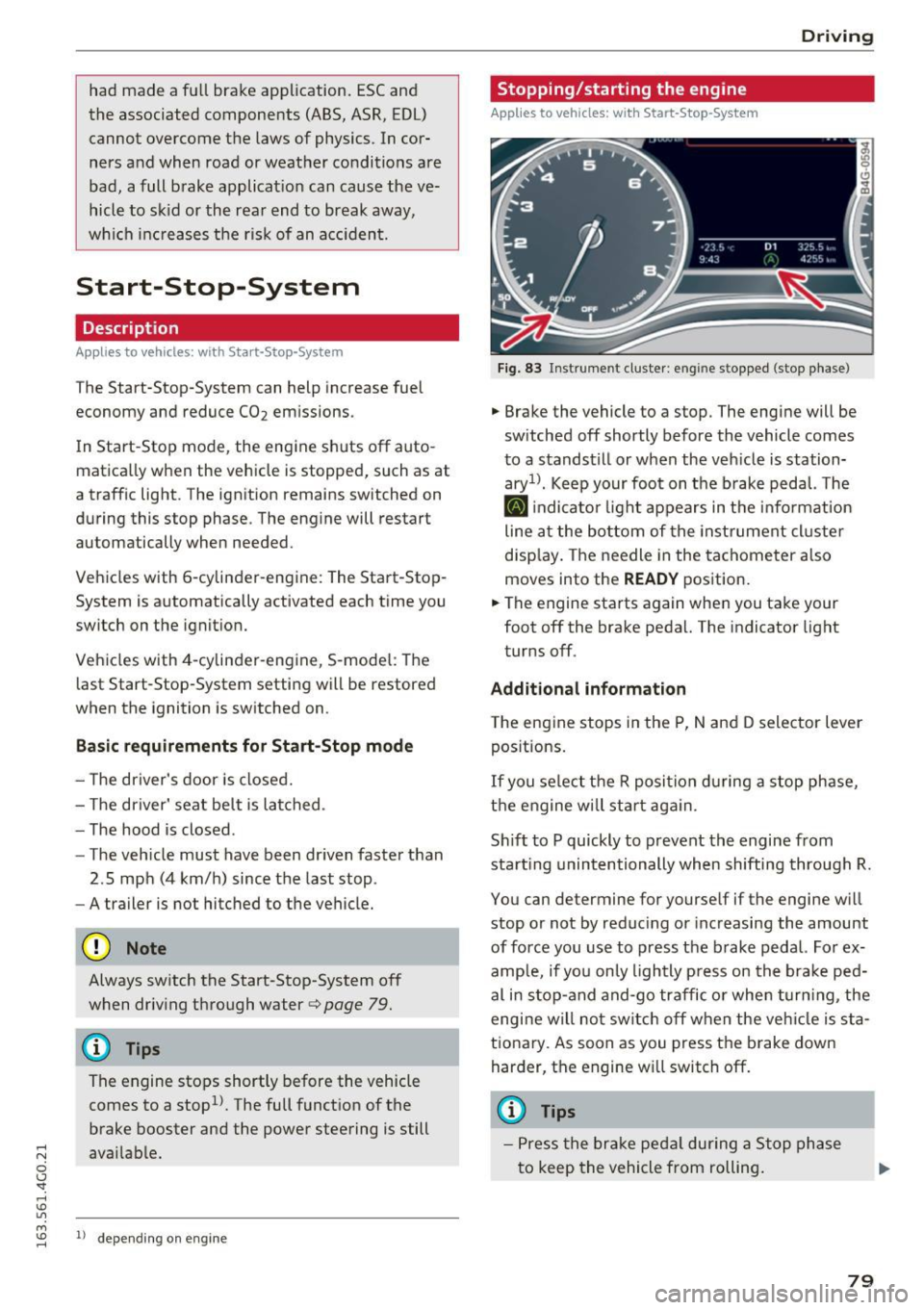
..... N
0 CJ '
the associated components (ABS, ASR, EDL)
cannot overcome the laws of physics. In cor
ners and when road or weather conditions are
bad, a full brake applicat ion can cause the ve
hicle to s kid or the rea r end to break away,
w hic h inc reases the r isk of an a cc iden t.
Start-Stop-System
Description
Applies to vehicles: with Sta rt-Stop-System
T he Sta rt-Stop -System can help increase fuel
economy and reduce CO2 emissions .
I n Start -Stop mode , the eng ine sh uts
off auto
mat ica lly when the veh icle is stopped , such as at
a traffic light. The ignition remains switched on
during this stop phase. The eng ine will restart
automatically when needed.
Vehicles with 6 -cylinder-eng ine: The Start-Stop
System is a utomatically activated each time you
switch on the ignit ion.
Vehicles with 4-cylinder -eng ine, 5-mode l: Th e
l ast Start -Stop-System setting will be restored
when the ignition is switched on .
Basic requirements for Start -Stop mode
- T he driver's door is closed.
- T he driver' seat belt is la tched .
- The hood is closed .
- The veh icle must have been dr iven faster than
2.5 mph (4 km/h) since the last stop .
- A tra iler is not hitched to t he vehicle.
(D Note
Always sw itch the Start-Stop-System off
when dr iv ing th rough water
c:> page 79.
(D Tips
The e ngine sto ps shortly before the vehicle
comes to a stop
1l. The full funct io n of the
brake booster and the power steering is still
ava ilab le.
M ~ ll de pend ing on e ngine
D rivi ng
Stopping/starting the engine
Applies to vehicles: with Start-Stop -System
Fi g. 83 Inst rume nt c lu ste r: en gin e stopped (stop p hase )
"' Brake the vehicle to a stop. The engine will be
sw itched
off shortly before the vehicle comes
to a stands till or when the veh icle is station
aryn. Keep your foo t on the b rake pedal. The
II indicato r light appears in the info rmat ion
line a t the bo ttom of the instrument cl uste r
disp lay . T he needle in the tachometer a lso
moves into the
READY pos ition.
"' The engine sta rts again whe n you take your
foot
off the bra ke pedal. The indicator light
turns
off.
Additional information
T he engine stops in the P, N and D selector lever
pos itions.
If you se lect t he R posi tion d uring a stop phase,
t h e e ngine will sta rt aga in.
Sh if t to P quickly to p revent the engine from
sta rt ing unintentionally when shifting through R.
You can determine for yourse lf if the engine w ill
stop or not by reduc ing or increasing the amount
of force you use to press the b rake pedal. For ex
amp le, if yo u only ligh tly p ress on the bra ke pe d
al i n stop- and and -go traffic o r whe n turning, the
engi ne will no t sw itch
off w hen the ve hicle is sta
tiona ry. As soon as you press the brake down
harder, the engine w ill switch
off .
(D Tips
- P ress the brak e pe dal during a Stop ph ase
t o keep the vehicle from rolling.
79
Page 82 of 294
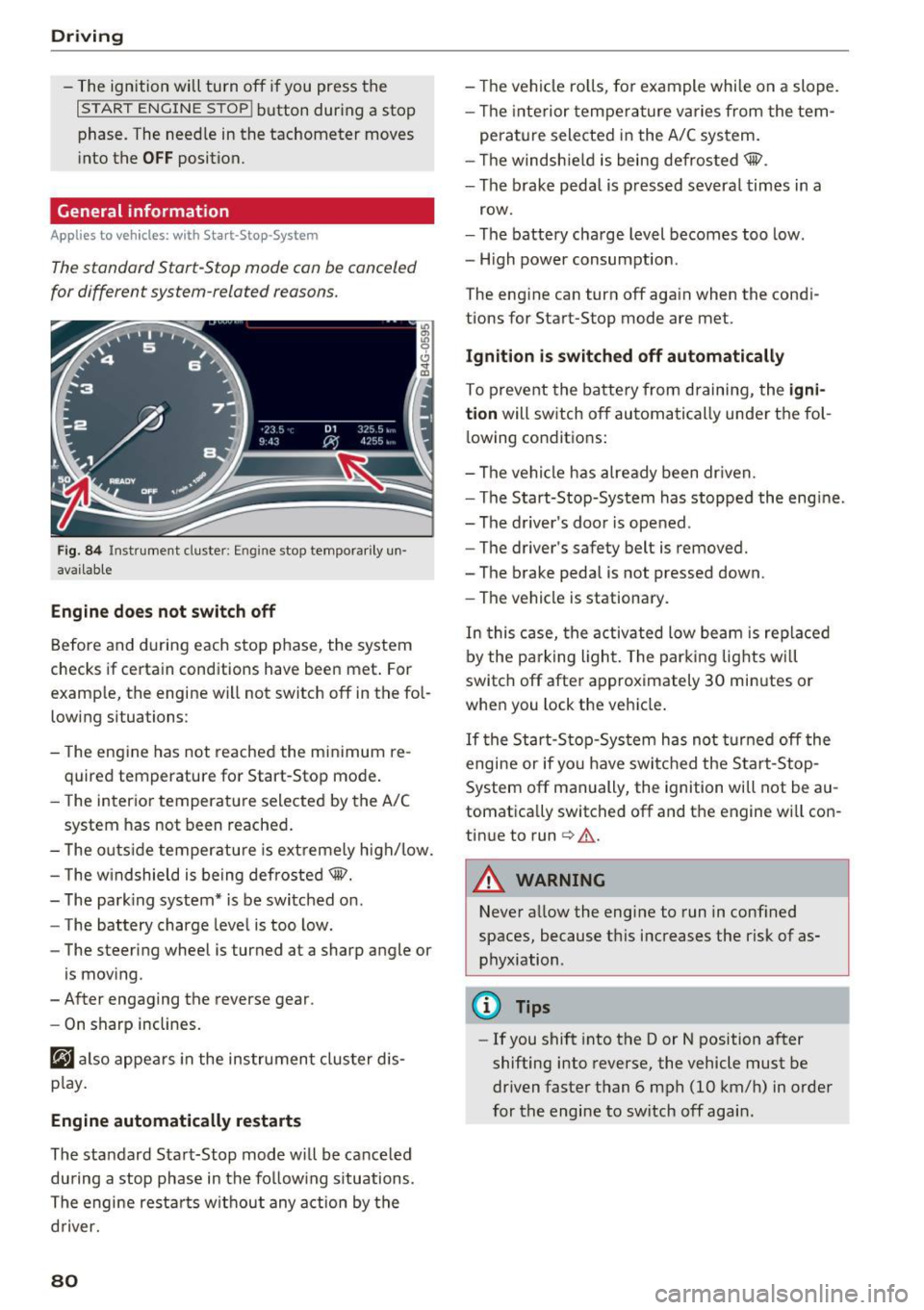
Driving
-The ignition will turn off if you press the
I STAR T ENGINE STOP! button during a stop
phase. The needle in the tachometer moves
into the
OFF position.
General information
Applies to veh icles: with Start-Stop-System
Th e standard Start-Stop mode con be canceled
for different system-related reasons.
Fig. 84 Instrument cluste r: En gin e stop temporarily un·
available
Engine does not switch off
Before and during each stop phase, the system
checks if certain conditions have been met. For
example, the engine will not switch
off in the fol
lowing situations :
- The engine has not reached the minimum re
quired temperature for Start-Stop mode.
- The interior temperature selected by the A/C
system has not been reached.
- The outside temperature is extremely high/low.
- The windshield is being defrosted®.
- The parking system* is be switched on.
- The battery charge level is too low.
- The steering wheel is turned at a sharp angle or
is moving .
- After engaging the reverse gear .
- On sharp inclines.
@j also appears in the instrument cluster dis
play.
Engine automatically restarts
The standard Start-Stop mode will be canceled
during a stop phase in the following situations .
The engine restarts without any action by the
driver.
80
- The vehicle rolls, for example while on a slope.
- The interior temperature varies from the tem-
perature selected in the A/C system.
- The windshield is being defrosted®.
- The brake pedal is pressed several times in a
row.
- The battery charge level becomes too low.
- High power consumption.
The engine can turn
off again when the condi
tions for Start-Stop mode are met.
Ignition is switched off automatically
To prevent the battery from draining, the igni
tion
will switch off automatically under the fol·
lowing conditions:
- The vehicle has already been driven.
- The Start-Stop-System has stopped the engine.
- The driver's door is opened.
- The driver's safety belt is removed.
- The brake pedal is not pressed down .
- The vehicle is stationary.
In this case, the activated low beam is replaced
by the parking light. The parking lights will
switch
off after approximately 30 minutes or
when you lock the vehicle.
If the Start-Stop-System has not turned off the
engine or if you have switched the Start-Stop
System
off manually, the ignition will not be au
tomatically switched
off and the engine will con
tinue to run
cc> .&. .
A WARNING
Never allow the engine to run in confined
spaces, because this increases the risk of as
phyxiation .
(D Tips
-If you shift into the D or N position after
shifting into reverse, the vehicle must be
driven faster than 6 mph (10 km/h) in order
for the engine to switch off again .
Page 83 of 294
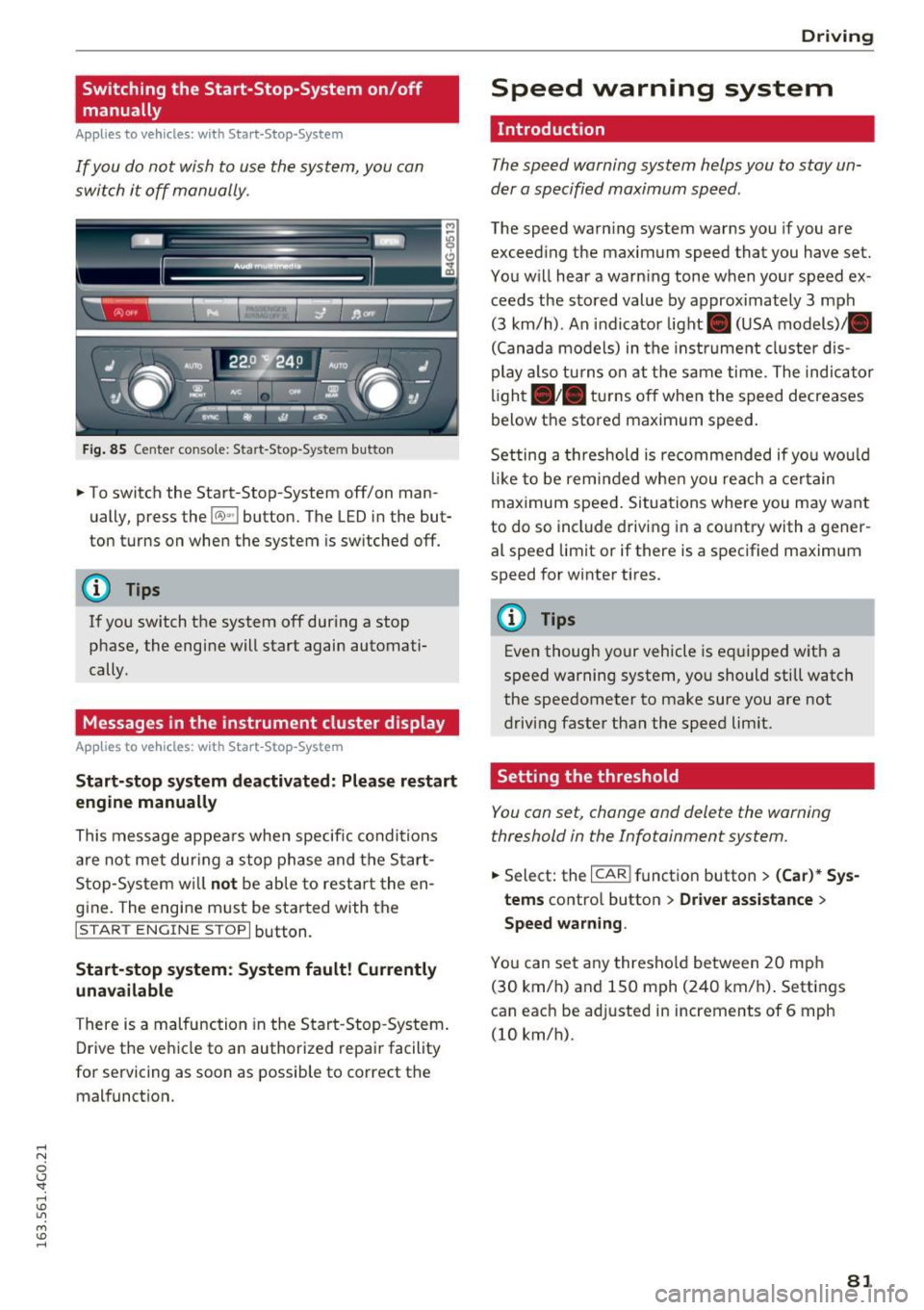
..... N
0 CJ '
Switching the Start-Stop-System on/off
manually
Applies to vehicles: with Start-Stop-System
If you do not wish to use the system, you can
switch it off manually .
Fig. 85 Center co nso le: Start -S top -Syste m but ton
.. To switch the Start -Stop-System off/on man
ually, press the
l(A)••I button. The L ED in the but
ton turns on when the system is sw itched off.
@ Tips
I f you switch the system off during a stop
phase, the engine will start again automati
cally.
Messages in the instrument cluster display
Applies to vehicles: with Start-Stop-Sys tem
Start-stop system deactivated: Please restart
engine manually
This message appea rs when specifi c condi tions
are not met dur ing a stop phase and t he S tart
S top -Sy stem w ill
not be able to resta rt the en
gine. The engine must be sta rted with the
I START ENGINE ST OPI button.
Start-stop system : System fault! Currently
unavailable
There is a mal function in the Start -Stop -System .
Drive the ve hicl e to an authorized repa ir facility
for servicing as soon as possible to correct the malfunct ion .
D rivi ng
Speed warning system
Introduction
The speed warning system helps you to stay un
der a specified maximum speed.
The speed warn ing system warns you if you are
exceed ing the maximum speed that you have set.
You will hear a warn ing tone when your speed ex
ceeds the s tored value by approx imately 3 mph
(3 km/h) . An indicator light . (USA models)/ .
(Canada models) in the instrume nt cl uste r d is
play a lso tu rns on at t he same time. The indicator
lig ht •• tur ns off when the speed decreases
below the stored maximum speed.
Setting a th reshold is recommended if yo u wo uld
lik e to be rem inded whe n you reach a cer tain
ma ximum speed. Situations where you may want
to do so incl ude driving in a co untry with a gener
al speed limit or if there is a spec ified maximum
speed for winter tires.
@ Tips
Eve n though your vehicle is eq uipped w ith a
speed warning system, yo u should still watch
the speedometer to make sure you are not
driving faster than the speed lim it.
Setting the threshold
You can set, change and delete the warning
threshold in the Infotainment system.
.. Select: the I CAR ! funct ion button > (Car) * Sys
tems
contro l button > Driver as sistance >
Speed warning .
You can set a ny thresho ld between 20 mp h
(30 km/h) and 150 mph (240 km/ h). Settings
can eac h be adjusted in increments of 6 mph
(10 km/h).
81
Page 86 of 294

Audi adaptive cruise control and braking guard
Audi adaptive cruise
control and braking
guard
Introduction
Applies to vehicles: with Audi adaptive cruise control
The adaptive cruise contro l system assists the
driver by regulating vehicle speed and helping to
maintain a set distance to the veh icle ahead ,
within the limits of the system. If the system de
tects a moving vehicle up ahead, adaptive cruise
control can brake and then accelerate your vehi
cle. This helps to make driving more comfortable
both on long highway stretches and in stop-and
go traffic.
The braking guard system can warn you about an
impending collision and initiate braking maneu
vers
c::> page 90.
Adaptive cruise control and braking guard have
technical limitations that you must know, so
please read this section carefully, understand
how the system works and use them properly at
all times.
General information
General information
Applies to vehicles: with Audi adaptive cruise control
Fig. 88 Front of the ve hicle: sensors and video camera
The areas that contain the radar and ultrasonic
sensors and the video camera
c::> fig. 88 must nev
er be covered by stickers or othe r objects or ob
structed with dirt, insects, snow or ice that will
interfere with the adaptive cruise control system
and braking guard. For information on cleaning,
84
refer to c::> page 203. The same applies for any
modifications made in the front area .
The function of the adaptive cruise control sys
tem and braking guard is limited under some
conditions:
- Objects can only be detected when they are
w ithin sensor range
c::>page 86, fig. 91.
- Th e system has a limited ability to detect ob
jects that are a short distance ahead, off to the
side of you r vehicle or moving into your lane .
- Some kinds of vehicles are hard to detect; for
example motorcycles, veh icles with high
ground clearance or overhanging loads may be
detected when it is too late or they may not be
detected at all.
- When driving through curves
c::> page 85.
-Stationary objects c::> page 85.
A WARNING
Always pay attention to traffic when adaptive
cruise control is switched on and braking
guard is active. As the driver, you are still re
sponsible for starting and for maintaining
speed and distance to other objects. Braking
guard is used to assist you. The driver must
always take act ion to avoid a collision . The
driver is always respons ible for braking at the
correct time.
- Improper use of adaptive cruise control can cause collisions , other accidents and serious
personal injury.
- Never let the comfort and convenience that
adapt ive cru ise control and braking guard
offe r dist ract you from the need to be alert
to traffic conditions and the need to remain
in fu ll contro l of your ve hicle at all times,
- Always remember that the adaptive cruise
control and braking guard have limits -they
will no t slow the vehicle down or maintain
the set distance when you drive towards an
obstacle or something on or near the road
that is not moving, s uch as vehicles stopped
in a traff ic jam, a stalled or disab led vehicle.
If registered by the radar sensors, vehicles
or obstacles that are not moving can trigger
a co llision warning and if confirmed by the
video camera, an acute co llision warning.
Page 90 of 294

Audi adaptive cruise control and braking guard
Driving in stop-and-go traffic
Applies to vehicles: with Audi adaptive cruise control
The adaptive cruise control system also assists
you in stop-and-go traffic.
If a previous detected
vehicle ahead stops, your vehicle will brake to a
stop, within the limits of the system.
• To resume driving with adaptive cruise control,
tap the accelerator pedal or
• Pull the lever toward you into position @
¢ page 88, fig. 95.
(Di Tips
-If adaptive cruise control is active and your
vehicle does not start driving as expected
after pulling the lever once, you can start
out again by tapping the accelerator pedal.
- If an obstacle is detected when your vehicle
starts driving, the system will prompt you
to take over¢
page 89. Your vehicle will
drive more slowly when starting. This may
also happen in some situations when no ob
stacle is apparent.
Interrupting cruise control
Applies to vehicles: with Audi adaptive cruise contro l
Fig. 95 Selector lever
Requirement: The adaptive cruise control is
switched on.
Overriding cruise control
• To accelerate manually, pull the lever toward
you into position@and hold it there. The mes
sage
ACC: Override appears. Or
• press the accelerator pedal.
• To resume cruise control, release the lever or
take your foot off the accelerator pedal.
88
Canceling cruise control while driving
• Move the lever into position @. The message
ACC: Standby appears. Or
• press the brake pedal.
• To resume the stored speed, move the lever in
to position @.
Canceling cruise control when stopped
• Push the lever away from you into position@.
The message
ACC: Standby appears.
• To resume cruise control, press the brake pedal
and pull the lever toward you into position @.
A WARNING
It is dangerous to activate cruise control and
resume the stored speed when the current
road, traffic or weather conditions do not per
mit this . This could result in a crash.
Setting the distance
Applies to vehicles: with Audi adapt ive cruise control
Fig. 96 Selector lever: setting the dista nce
• Tap the switch to display the current set dis
tance ¢
fig. 96.
• To increase or reduce the distance by incre
ments, tap the switch again to the left or right.
The distance between the two vehicles will
change in the instrument cluster display.
When approaching a moving vehicle up ahead,
the adaptive cruise control system automatically brakes to match that object's speed and then
maintains the stored distance.
If the vehicle
ahead accelerates, adaptive cruise control will al-
so accelerate up to the stored speed.
II--
Page 103 of 294
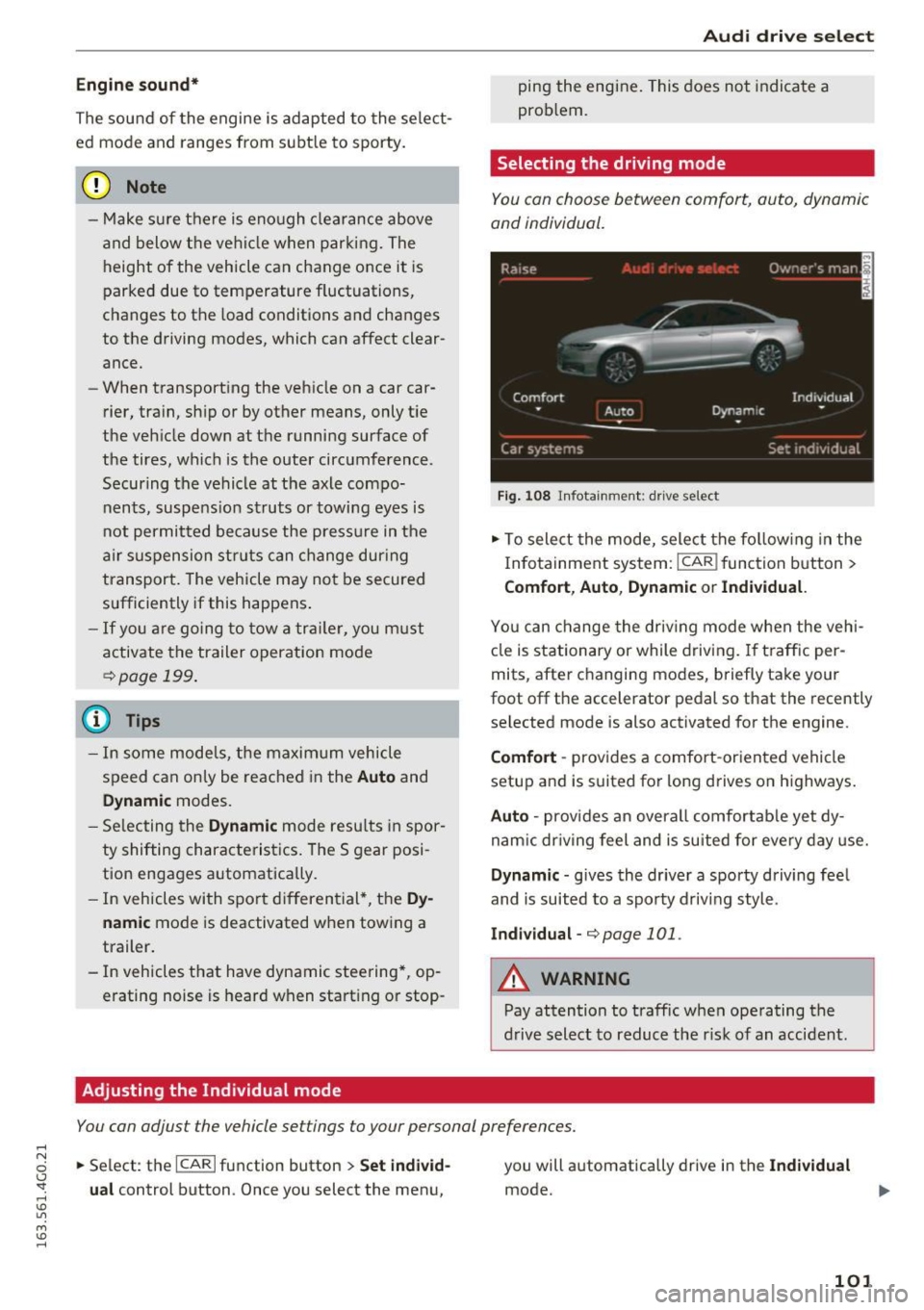
.... N
0 CJ '
Engine sound *
The sou nd of the engine is adapted to the select
ed mode and ranges from subt le to sporty.
(D Note
- Make sure there is enough cle arance above
and below t he vehicle when parking. The
height of the vehicle can change once it is
parked due to temperature f luctuations,
changes to the load conditions and changes
to the driving modes, which can affect clear
ance.
- When transporting the vehicle on a car car
rier, tra in, ship or by other means, only t ie
the vehicle down at the running surface of
the tires, which is the outer circumference.
Securing the vehicle at the axle compo
nents, suspe ns ion struts or towing eyes is
not permitted be cause the press ure in the
air suspension struts can change dur ing
transport . The vehicle may not be secured
sufficiently if this happens .
-If yo u are going to tow a tra ile r, you m ust
activate the trailer operation mode
r:!;> page 199 .
(D Tips
-In some models, the maximum vehicle
speed can only be reached in the
Auto and
D ynami c modes.
- Se lecting the
D ynamic mode resu lts in spor
ty shifting characteristics. The S gear posi
tion engages a utomatically.
- In vehicles with spo rt d ifferen tial *, the
D y
n amic
mode is deactivated when towing a
trailer .
- In vehicles that have dynamic steering*, op
erating noise is heard when start ing or stop -
Adjusting the Individual mode
Audi driv e se lect
ping the engine. This does not indicate a
prob lem.
Selecting the driving mode
You con choose between comfort, auto, dynamic
and individual.
F ig. 1 08 In fotainment: drive select
.,. To sele ct the mode, select the fo llow ing in the
I n fotainment system:
I CAR ! function button >
Comfort , Auto , Dynam ic or Indi vidual.
Yo u can change the driv ing mode when the vehi
cle is stationary or while driving. If t raffic per
mits, after changing modes, briefly take your
foot off the accelerator pedal so that the recently selected mode is also activated for the engine.
Comfort -provides a comfort-oriented vehicle
setup and is suited for long d rives on h ighways .
Auto -provides an overa ll comfortab le yet dy
nam ic dr iving feel and is suited for every day use.
Dynamic -gives the driver a sporty driving fee l
and is suited to a sporty driv ing style.
Indi vidual -r:!;> page 101 .
A WARNING
Pay attention to traffic when operating the
d rive select to reduce the risk of an accident.
You con adjust the vehicle settings to your personal preferences .
.,. Se lect: the ICARI function button > Set indi vid
u al
control button . Once you select the menu, you will a
utomatically drive in the
Indi vidual
mode .
101
Page 110 of 294
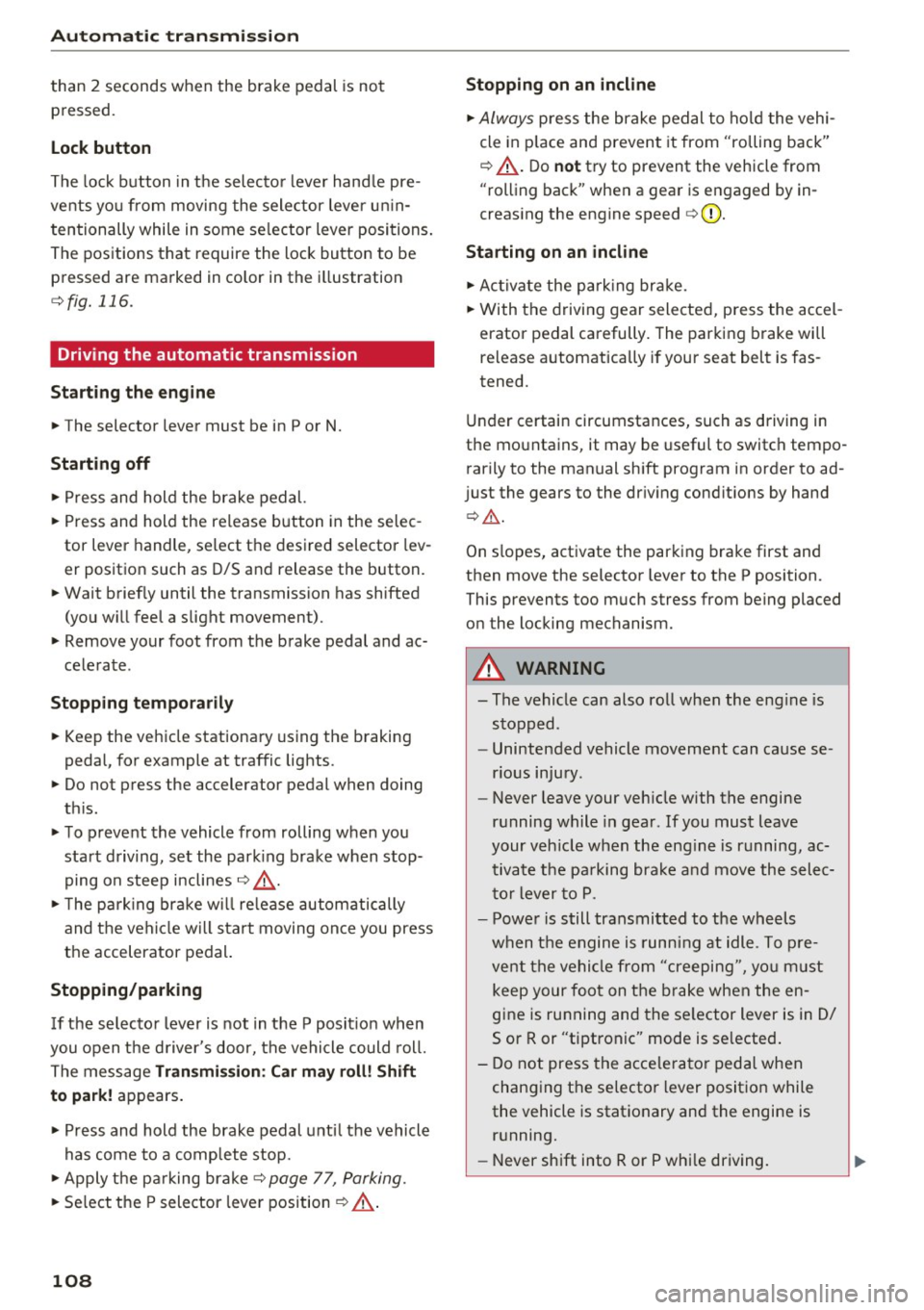
Automatic transmissio n
than 2 seconds when the brake pedal is not
pressed.
Lock button
The lock button in the selecto r lever hand le pre
ve nts yo u from moving the selector lever un in
tentionally while in some se lector lever positions .
The positions that require the lock button to be
pr essed are marked in co lor in the i llustration
¢ fig. 116 .
Driving the automatic transmission
Starting the engine
~ T he selector lever must be in P or N.
Starting off
~ Press and hold the brake pedal.
~ Press and hold the release button in the selec
tor lever handle, se lect the des ired selector lev
er position such as D/S and r ele ase the button.
~ Wait briefly until the transmission has shifted
(you w ill feel a slight movement).
~ Remove your foot from the brake pedal and ac
celerate .
Stopping t emporar ily
~ Keep the vehicle stationary using the braking
pedal , for example at traffic lights .
~ Do not press the accelerator pedal when doing
th is .
~ To prevent the vehicle from rolling when you
start driving, set the park ing brake when stop
ping on steep inclines¢,& .
~ The pa rk ing brake w ill release automatically
and the vehi cle will start moving once you press
the accelerator pedal.
Stopping /parking
If the se lector lever is not in the P posit ion when
you open the d river's door, the vehicle could roll.
The message
Tran smission : Car ma y roll! Shift
to park!
appears .
~ Press and hold the brake pedal unt il the vehicle
has come to a complete stop.
~ Apply the pa rking brake ¢ page 77, Parking .
~ Select the P selector leve r position ¢ ,& .
108
Stopping on an incline
~ Always press the brake pedal to ho ld the vehi
cle in p lace and prevent it from "rolling back"
¢
,& . Do not try to prevent the vehicle from
"rolling back" when a gear is engaged by in
creas ing the engine speed ¢(D .
Starting on an inclin e
~ Activate the pa rk ing br ake.
~ With the driving gear selected, press the accel
erator pedal carefully. The parking brake will
re lease a utomatically if your seat belt is fas
tened.
Under certain circumstances, such as driving in
the mountains, it may be useful to switch tempo rarily to the manual sh ift program in order to ad
j ust the gears to the dr iv ing cond it ions by hand
Q ,&. .
On s lopes, activate the parking brake first and
then move the selector lever to the P position.
This prevents too much stress from being placed
on the locking mechanism.
A WARNING
- The vehicle can also roll when the eng ine is
stopped .
- Unintended vehicle movement can cause se
rious injury .
- Never leave your veh icle with the engine
r u nning while in gear. If you must leave
your veh icle when the eng ine is r unning, ac
tivate t he pa rking bra ke a nd move the selec
to r lever to P.
- P owe r is still transmitted to the wheels
when the engine is runn ing a t idle . To p re
ve nt the vehicle from "creeping ", yo u m ust
keep your foot on the b rake when the en
gine is running and the se lector lever is in D/
5 or R or "tiptronic" mode is se lected .
- D o not press the acce le ra tor peda l when
changing the se lector lever posit ion while
the vehicle is stationary and the engine is
r u nning.
- Never sh ift into R or P whi le driving.